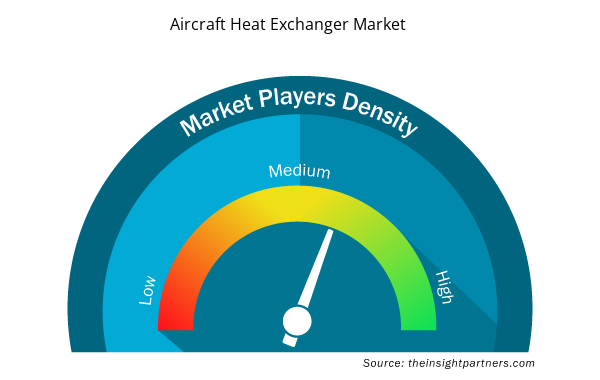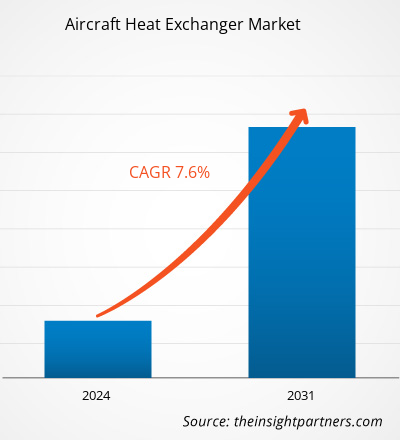航空機熱交換器市場規模は、2023年の19億7,000万米ドルから2031年には35億4,000万米ドルに達すると予測されています。市場は2023年から2031年にかけて7.6%のCAGRを記録すると予想されています。世界の航空機製造業界には、世界中に多数の定評のある企業があり、今後数年間で買い手の交渉力は高いレベルに成長すると予想されています。市場には多数の熱交換器サプライヤーが存在するため、航空機メーカーには、より高品質の製品、より良い顧客サービス、より低い価格を提供する最適なメーカーを選択するためのいくつかのオプションがあります。
航空機熱交換器市場分析
航空機熱交換器の需要は、航空機メーカーや航空会社の間で急増しています。航空機熱交換器の設計者は、設計プロセスを容易にするために、付加製造などの高度な技術の開発に莫大な金額を費やしています。この要因は、熱交換器の設計者、製造者、およびサプライヤーの顧客を引き付けています。航空会社は、OEM を通じて航空機熱交換器を調達しています。また、ボーイングやエアバスなどの航空機メーカーは、顧客を説得して、新しい航空機に高度な製品を統合させています。これも、航空機熱交換器市場の急増を促進しています。
航空機熱交換器市場の概要
航空機熱交換器市場は、今後数年間で堅調な成長が見込まれます。市場の成長は、以下のいくつかの要因に起因しています。
- さまざまな地域での民間航空機の増加
- 軍用機の調達増加
- 航空機の運航効率向上のため、民間航空機の効率的な冷暖房の必要性が高まっている
これらの要因は、航空機熱交換器市場のプラス成長という点で大きな影響を及ぼす可能性があります。効果的な熱と冷却の管理の必要性は、さまざまな民間航空会社の新しい航空機と既存の航空機群に熱交換器を新しく設置する需要を生み出すもう 1 つの主要な要因です。さらに、軍用機の調達と注文の増加も、軍用機への熱交換器の採用を促進するもう 1 つの主要な要因です。
要件に合わせてレポートをカスタマイズする
このレポートの一部、国レベルの分析、Excelデータパックなど、あらゆるレポートを無料でカスタマイズできます。また、スタートアップや大学向けのお得なオファーや割引もご利用いただけます。
- このレポートの主要な市場動向を入手してください。この無料サンプルには、市場動向から見積もりや予測に至るまでのデータ分析が含まれます。
航空機熱交換器市場の推進要因と機会
さまざまな地域での民間航空機の増加
さまざまな地域で運航する航空会社からの新しい航空機の需要の高まりは、世界中の航空機フリートのサイズを世界的に押し上げる主な要因の1つです。 2023年、世界の商用航空機フリートのサイズは約27,385機で、2024年には28,398機の商用航空機に達しました。 このようなフリートの増加により、さまざまな地域で航空機熱交換器の需要が高まっています。 さらに、エアバスとボーイングのデータによると、今後の納入(つまり、2023年から2042年の間に40,000機以上の航空機が納入される予定)も、今後数年間で航空機熱交換器の市場を牽引する可能性があります。
将来の機会を提供する軍用無人航空機の配備
各国の軍隊におけるUAV配備数の増加は、UAV セグメントにおける熱交換器の新規設置の新たな機会を生み出す可能性のある主な要因の 1 つです。さらに、これは、軍用 UAV の調達にさらに多くの費用を費やしている世界中のさまざまな国での軍事費の増加によってもサポートされています。このような要因は、今後数年間で航空機熱交換器市場に新たな機会を生み出す可能性があります。
航空機熱交換器市場レポートのセグメンテーション分析
航空機熱交換器市場分析の導出に貢献した主要なセグメントは、タイプ、航空機の種類、用途、製造の種類、および地理です。
- タイプに基づいて、市場はフラットチューブとプレートフィンに分類されています。プレートフィンセグメントは2023年に大きな市場シェアを占めました。
- 航空機の種類別に見ると、市場は固定翼航空機、回転翼航空機、UAVに区分されています。固定翼航空機セグメントは2023年に市場で最大のシェアを占めました。
- 用途別に見ると、市場はエンジンと機体に分かれており、2023年にはエンジンセグメントが市場を支配しました。
- 製造タイプ別に見ると、市場は従来型と付加製造型に分かれており、2023年には従来型セグメントが市場を支配しました。
航空機熱交換器の地域別市場シェア分析
航空機熱交換器市場レポートの地理的範囲は、主に北米、ヨーロッパ、アジア太平洋、中東およびアフリカ、南米の 5 つの地域に分かれています。
2023年の航空機熱交換器市場は北米が優勢でしたが、アジア太平洋地域は予測期間中に大幅な成長が見込まれます。北米地域には、米国、カナダ、メキシコが含まれます。米国は2023年に北米の航空機熱交換器市場を支配しました。これは主に、航空旅客数の増加と全国の航空機艦隊の規模の拡大によるものです。さらに、今後20年間の航空機の納入は、北米地域の市場ベンダーに新たな機会を生み出すでしょう。たとえば、エアバスの世界市場予測レポートによると、2023年から2042年の間に6,970機以上の商用航空機が納入されると予想されています。これにより、今後数年間で航空機熱交換器の新たな需要が生まれます。
航空機熱交換器市場の地域別分析
予測期間を通じて航空機熱交換器市場に影響を与える地域的な傾向と要因は、Insight Partners のアナリストによって徹底的に説明されています。このセクションでは、北米、ヨーロッパ、アジア太平洋、中東、アフリカ、南米、中米にわたる航空機熱交換器市場のセグメントと地理についても説明します。

- 航空機熱交換器市場の地域別データを入手
航空機熱交換器市場レポートの範囲
| レポート属性 | 詳細 |
|---|---|
| 2023年の市場規模 | 19億7千万米ドル |
| 2031年までの市場規模 | 35億4千万米ドル |
| 世界のCAGR(2023年~2031年) | 7.6% |
| 履歴データ | 2021-2022 |
| 予測期間 | 2024-2031 |
| 対象セグメント | タイプ別
|
| 対象地域と国 | 北米
|
| 市場リーダーと主要企業プロフィール |
|
航空機熱交換器市場のプレーヤー密度:ビジネスダイナミクスへの影響を理解する
航空機熱交換器市場は、消費者の嗜好の変化、技術の進歩、製品の利点に対する認識の高まりなどの要因により、エンドユーザーの需要が高まり、急速に成長しています。需要が高まるにつれて、企業は提供を拡大し、消費者のニーズを満たすために革新し、新たなトレンドを活用し、市場の成長をさらに促進しています。
市場プレーヤー密度とは、特定の市場または業界内で活動している企業または会社の分布を指します。これは、特定の市場スペースに、その市場規模または総市場価値に対してどれだけの競合相手 (市場プレーヤー) が存在するかを示します。
航空機熱交換器市場で事業を展開している主要企業は次のとおりです。
- ボイドコーポレーション
- コリンズエアロスペース
- ハネウェルインターナショナル株式会社
- ジャムコ株式会社
- リープヘルグループ
- メギットPLC
免責事項:上記の企業は、特定の順序でランク付けされていません。

- 航空機熱交換器市場のトップキープレーヤーの概要を入手
航空機熱交換器市場のニュースと最近の動向
航空機熱交換器市場は、重要な企業出版物、協会データ、データベースを含む一次調査および二次調査後の定性的および定量的データを収集することによって評価されます。以下は、航空機熱交換器市場の動向と戦略のリストです。
- 2023年6月、サフランエアロブースターは、革新的な空力設計に基づく高性能熱交換器の新シリーズHIPEXをパリ航空ショーで発表しました。(出典:サフラングループ、プレスリリース/企業ウェブサイト/ニュースレター)
- 2023 年 5 月、航空機整備、修理、オーバーホール (MRO) サービスの大手プロバイダーである AMETEK MRO AEM は、英国ラムズゲート施設の熱交換器機能を拡張しました。(出典: AMETEK、プレスリリース/企業 Web サイト/ニュースレター)
航空機熱交換器市場レポートの対象範囲と成果物
「航空機熱交換器市場の規模と予測(2021〜2031年)」レポートでは、以下の分野をカバーする市場の詳細な分析を提供しています。
- 対象範囲に含まれるすべての主要市場セグメントの世界、地域、国レベルでの市場規模と予測
- 市場の動向(推進要因、制約、主要な機会など)
- 今後の主な動向
- ポーターのファイブフォース分析の詳細
- 主要な市場動向、主要プレーヤー、規制、最近の市場動向を網羅した世界および地域の市場分析
- 市場集中、ヒートマップ分析、主要プレーヤー、最近の動向を網羅した業界の状況と競争分析
- SWOT分析による詳細な企業プロフィール
- 過去2年間の分析、基準年、CAGRによる予測(7年間)
- PEST分析とSWOT分析
- 市場規模価値/数量 - 世界、地域、国
- 業界と競争環境
- Excel データセット



Report Coverage
Revenue forecast, Company Analysis, Industry landscape, Growth factors, and Trends

Segment Covered
This text is related
to segments covered.

Regional Scope
North America, Europe, Asia Pacific, Middle East & Africa, South & Central America

Country Scope
This text is related
to country scope.
Trends and growth analysis reports related to Aerospace and Defense : READ MORE..
The Insight Partners performs research in 4 major stages: Data Collection & Secondary Research, Primary Research, Data Analysis and Data Triangulation & Final Review.
- Data Collection and Secondary Research:
As a market research and consulting firm operating from a decade, we have published and advised several client across the globe. First step for any study will start with an assessment of currently available data and insights from existing reports. Further, historical and current market information is collected from Investor Presentations, Annual Reports, SEC Filings, etc., and other information related to company’s performance and market positioning are gathered from Paid Databases (Factiva, Hoovers, and Reuters) and various other publications available in public domain.
Several associations trade associates, technical forums, institutes, societies and organization are accessed to gain technical as well as market related insights through their publications such as research papers, blogs and press releases related to the studies are referred to get cues about the market. Further, white papers, journals, magazines, and other news articles published in last 3 years are scrutinized and analyzed to understand the current market trends.
- Primary Research:
The primarily interview analysis comprise of data obtained from industry participants interview and answers to survey questions gathered by in-house primary team.
For primary research, interviews are conducted with industry experts/CEOs/Marketing Managers/VPs/Subject Matter Experts from both demand and supply side to get a 360-degree view of the market. The primary team conducts several interviews based on the complexity of the markets to understand the various market trends and dynamics which makes research more credible and precise.
A typical research interview fulfils the following functions:
- Provides first-hand information on the market size, market trends, growth trends, competitive landscape, and outlook
- Validates and strengthens in-house secondary research findings
- Develops the analysis team’s expertise and market understanding
Primary research involves email interactions and telephone interviews for each market, category, segment, and sub-segment across geographies. The participants who typically take part in such a process include, but are not limited to:
- Industry participants: VPs, business development managers, market intelligence managers and national sales managers
- Outside experts: Valuation experts, research analysts and key opinion leaders specializing in the electronics and semiconductor industry.
Below is the breakup of our primary respondents by company, designation, and region:

Once we receive the confirmation from primary research sources or primary respondents, we finalize the base year market estimation and forecast the data as per the macroeconomic and microeconomic factors assessed during data collection.
- Data Analysis:
Once data is validated through both secondary as well as primary respondents, we finalize the market estimations by hypothesis formulation and factor analysis at regional and country level.
- Macro-Economic Factor Analysis:
We analyse macroeconomic indicators such the gross domestic product (GDP), increase in the demand for goods and services across industries, technological advancement, regional economic growth, governmental policies, the influence of COVID-19, PEST analysis, and other aspects. This analysis aids in setting benchmarks for various nations/regions and approximating market splits. Additionally, the general trend of the aforementioned components aid in determining the market's development possibilities.
- Country Level Data:
Various factors that are especially aligned to the country are taken into account to determine the market size for a certain area and country, including the presence of vendors, such as headquarters and offices, the country's GDP, demand patterns, and industry growth. To comprehend the market dynamics for the nation, a number of growth variables, inhibitors, application areas, and current market trends are researched. The aforementioned elements aid in determining the country's overall market's growth potential.
- Company Profile:
The “Table of Contents” is formulated by listing and analyzing more than 25 - 30 companies operating in the market ecosystem across geographies. However, we profile only 10 companies as a standard practice in our syndicate reports. These 10 companies comprise leading, emerging, and regional players. Nonetheless, our analysis is not restricted to the 10 listed companies, we also analyze other companies present in the market to develop a holistic view and understand the prevailing trends. The “Company Profiles” section in the report covers key facts, business description, products & services, financial information, SWOT analysis, and key developments. The financial information presented is extracted from the annual reports and official documents of the publicly listed companies. Upon collecting the information for the sections of respective companies, we verify them via various primary sources and then compile the data in respective company profiles. The company level information helps us in deriving the base number as well as in forecasting the market size.
- Developing Base Number:
Aggregation of sales statistics (2020-2022) and macro-economic factor, and other secondary and primary research insights are utilized to arrive at base number and related market shares for 2022. The data gaps are identified in this step and relevant market data is analyzed, collected from paid primary interviews or databases. On finalizing the base year market size, forecasts are developed on the basis of macro-economic, industry and market growth factors and company level analysis.
- Data Triangulation and Final Review:
The market findings and base year market size calculations are validated from supply as well as demand side. Demand side validations are based on macro-economic factor analysis and benchmarks for respective regions and countries. In case of supply side validations, revenues of major companies are estimated (in case not available) based on industry benchmark, approximate number of employees, product portfolio, and primary interviews revenues are gathered. Further revenue from target product/service segment is assessed to avoid overshooting of market statistics. In case of heavy deviations between supply and demand side values, all thes steps are repeated to achieve synchronization.
We follow an iterative model, wherein we share our research findings with Subject Matter Experts (SME’s) and Key Opinion Leaders (KOLs) until consensus view of the market is not formulated – this model negates any drastic deviation in the opinions of experts. Only validated and universally acceptable research findings are quoted in our reports.
We have important check points that we use to validate our research findings – which we call – data triangulation, where we validate the information, we generate from secondary sources with primary interviews and then we re-validate with our internal data bases and Subject matter experts. This comprehensive model enables us to deliver high quality, reliable data in shortest possible time.


 このレポートの無料サンプルを入手する
このレポートの無料サンプルを入手する